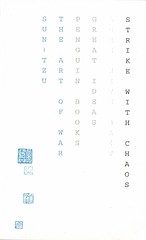 This is the fifth book I (randomly) picked to read out of the Penguin Great Ideas Series. It's number 22 in the list and part of series two (the blue series).
This is the fifth book I (randomly) picked to read out of the Penguin Great Ideas Series. It's number 22 in the list and part of series two (the blue series).For me, 'The Art of War' came at a good time. After the dense, heavy reading of 'The Social Contract', The Art of War seemed beautifully sparse.
"OMG! It's a friggin poem!!' was my immediate reaction when I first flicked through the book. It's not a poem, but the text is arranged in very short paragraphs along the left hand side of the page. There's a lot of white space which give the text a lovely sculptural feeling, which is also reflected in the layout of the cover. From a practical point of view, laying out the text in this way has made 'The Art of War' a 'slim' book, rather than the ultra-skinny book it would have been otherwise, but the layout also suits the text, and I guess was probably ultimately a product of the original way in which the text was laid out on bamboo strips (see here). I'd be interested to know whether this layout was a design choice by Penguin, or if all editions of' The Art of War' are laid out like this by default.
As to the words themselves, I found this treatise on military strategy oddly charming. It's an interesting mixture of very practical advice (for example, it discusses the amount of money you need to run an army, describes different types of terrain) and more philosophical thoughts (know your enemy and know yourself). I can't quite see how it is applied to modern business and managerial strategy, but it wasn't really looking at if from that point of view so probably missed it. I suspect that 'The Art of War' may be a book I revisit later on to spend more time thinking about the text a bit more fully, now that I have a general idea of what it is about.
The book is laid out in thirteen different sections/chapters, and comparison of the chapters titles in the book to those mentioned in the wiki page show that this translation by John Minford is relatively new. Indeed further googling shows that John Minford's translation was first published by Viking in 2002 and included both the unadorned text, plus further commentary. I think that in this case further commentary would be very valuable in gaining the most out of the text (and, actually, I think this may well turn out to be true for many of the 'Great Ideas').
No comments:
Post a Comment